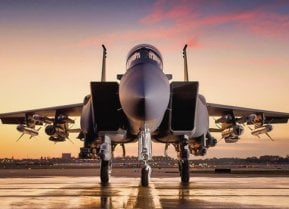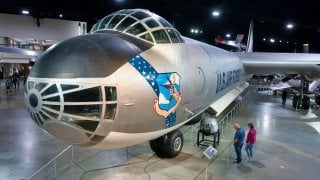The B-36 Bomber Was Built to Bomb Russia if World War III Ever Started
While U.S. officials initially desired a bomber that could travel just under 6,000 miles without needing to refuel, the B-36 far exceeded this expectation.
A Cold War-era bomber continues to hold the record as the largest American warplane ever created, despite the fact the platform has been out of service for more than seven decades. The B-36 Peacemaker bomber was designed to travel roundtrip from New England to Leningrad without needing to refuel in the late 1940’s.
As the Cold War was heating up, the ability to counterbalance the threats of Soviet missile attacks was paramount for the U.S. While the B-36 served as a powerful deterrent when it entered service with the newly formed Air Force, the bomber never actually saw any combat action.
A Brief History of the B-36’s origins
The need for a strategic bomber that could travel thousands of miles without needing to be refueled became apparent to the U.S. during the Second World War.
If Britain collapsed due to the German “Blitz,” America’s limited aerial bombing capabilities would mean that an attack from above against Germany by the U.S. Army Air Corps would be impossible. For this reason, U.S. officials recognized that developing a bomber with a range of at least 5,700 miles was essential. As the Pacific war progressed, the need for a bomber able to reach Japan from bases in Hawaii also fastened the development of the Peacemaker. Around this time, the U.S. ordered an initial production run of 100 B-36s from manufacturer Convair. By 1946, the massive bomber took to the skies for the first time.
Specs and Capabilities
While U.S. officials initially desired a bomber that could travel just under 6,000 miles without needing to refuel, the B-36 far exceeded this expectation. In fact, the Peacemaker had a 10,000-mile range. With a 230-foot long wingspan, the B-36 still holds the title for longest wingspan of any combat aircraft ever developed.
As noted in a Sandboxx News article, “Its wingspan was so big, in fact, that you could lay a B-52 Stratofortress’ wings over the B-36’s and still have room to throw a Super Hornet on the end for good measure.”
Ordnance-wise, the B-36 was armed to the teeth. The airframe could carry roughly 86,000 pounds of nuclear or conventional bombs, a capacity more than 15,000 pounds greater than the U.S. Air Force’s current B-52 bomber. Six Pratt & Whitney 3600 hp, R 4360-53 radial piston engines combined with four General Electric 13,500 lb thrust J47-19 turbojets powered the hefty airframe, allowing it to fly at speeds reaching 435 miles per hour.
As detailed in the Aviation Geek Club, ‘While the cruise speed of the B-36 was basically the same as the B-29 (around 235 MPH) it could do it at over 40,000 feet! There were no anti-aircraft cannon that could reach that altitude in World War II. Its range of 4,000 miles (in the early versions) with a 10,000 lb payload didn’t quite give it the range to attack Japan from the Aleutians but it could easily attack Berlin from Iceland. For shorter distances, the aircraft could carry up to 72,000 lbs of bombs.”
Today, the legendary B-36 Peacemakers have been relegated to museum duty. However, the platform that never saw combat remains revered by aviation buffs.
About the Author
Maya Carlin is an analyst with the Center for Security Policy and a former Anna Sobol Levy Fellow at IDC Herzliya in Israel. She has by-lines in many publications, including The National Interest, Jerusalem Post, and Times of Israel. You can follow her on Twitter: @MayaCarlin.


